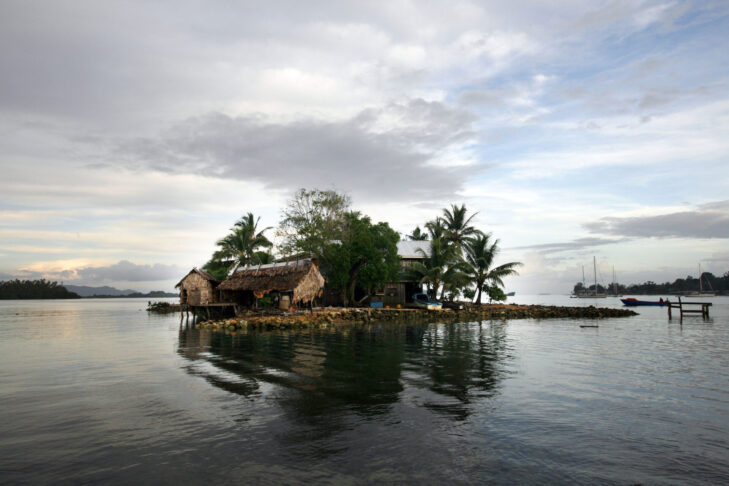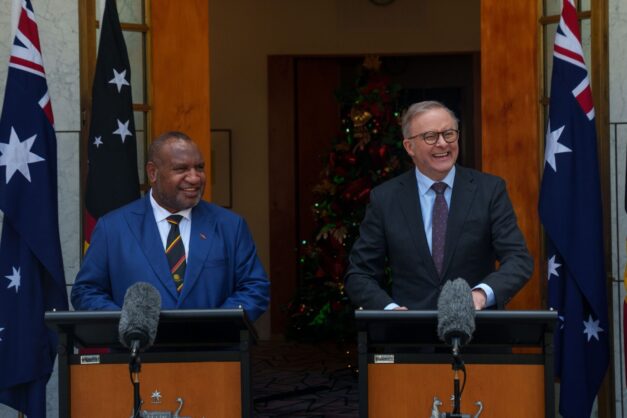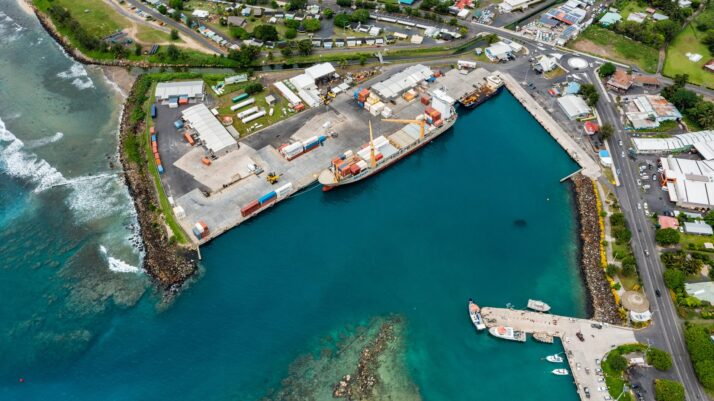Should Australia’s new Pacific Engagement Visa prioritise climate refugees?

Photo: Rob Maccoll for AusAID
The recently announced Pacific Engagement Visa offers a framework to help support Pacific Island countries struggling with internal climate-related displacement, Michael Kabuni and Akka Rimon write.
Australia’s new Labor Government has made improving relations with Pacific Island countries a focus of its foreign policy. In addition to frequent visits to the region by Foreign Minister Penny Wong, the government has also promised to improve existing labour schemes for Pacific Islanders and to focus more on climate change adaptation and mitigation.
A major initiative in this regard has been the Pacific Climate Infrastructure Partnership (PCIP), which aims to support the construction of new, climate disaster resilient infrastructure as the region deals with climate impacts and moves to cleaner energy sources.
But will building climate resilient infrastructure and cleaner energy sources prevent climate-vulnerable communities, like the Carteret Island in Papua New Guinea (PNG) or Tarawa in Kiribati, from being displaced from sea level rises? The immediate answer is no.
The painful truth is that, even if all existent coal mines were closed tomorrow, the impact of climate change on the region is already irreversible and existential.
As such, the issue for many has turned from preventing communities from sinking, to figuring out what to do when it happens. This is a major concern as Pacific Island nations often have limited options when it comes to internal resettlement.
Kiribati, a small island state located between Australia and Hawaii, is one example.
While its total land area is roughly the size of New York City, its exclusive economic zone is equivalent to the Indian sub-continent. Despite this, Kiribati’s minimal land elevation – barely three meters above sea level – makes it extremely vulnerable to climate change.
As a result, climate change is an existential threat to the atoll nation. Rapid coastal erosion, lack of water and food security, extreme climate patterns, rising sea levels, and prolonged droughts are all facts of daily life.
Unlike bigger countries with higher ground, I-Kiribati peoples have nowhere to go but across to the seas. Thankfully, there are options for those displaced by climate change. In 2003, the then Kiribati government introduced the migration with dignity policy, to help resettle Pacific peoples and promote labour mobility as an economic adaptation to climate change.
This paved way for the Kiribati-Australia Nursing Initiative (KANI) in 2006, the Seasonal Worker Program Pilot Scheme (SWPPS) in 2008, the Seasonal Worker Programme in 2012, and the Pacific Labour Scheme in 2018. The KANI scheme in particular engaged 90 nurses now working and living in Australia.
Domestically, the Kiribati Ministry of Employment works directly with Australian employers and recruitment agencies to facilitate training and recruitment of Kiribati youth through its Offshore Employment Division. This has seen an increase in the SWP from 11 workers in 2010 to 392 in 2021, with a parallel spike in the number of employers from 1 in 2010 to 18 in 2022.
PNG is another example. Despite being significantly larger than Kiribati and having higher elevations, it also faces significant problems with resettling climate refugees internally. Roughly 95 per cent of its land is owned by more than 1,000 clans and tribes. As a result, the government has limited space for those displaced by climate change.
A key example are the inhabitants of PNG’s Carteret Islands, who have been labelled the world’s first climate change refugees. Attempts to relocate the Cateret communities have been made through a Council of Elders called Tulele Pisa. This has resulted in plans for resettlement in Bougainville. Unfortunately, political, financial and land related issues have stalled advancement, reflecting the issues associated with many climate affected communities globally.
For PNG and other Melanesian countries, governments require assistance to develop resettlement plans and options for working with customary landowners to find space for refugees.
In March 2022, PNG and Australian governments signed the second bilateral Memorandum of Understanding under the new Pacific Australia Labour Mobility (PALM) scheme. PNG has one of the lowest number of workers participating in these schemes even though it has the largest population in the Pacific.
Furthermore, PNG and Kiribati have some of the lowest rates of out-bound migration in the world. According to the Organisation for Economic Co-operation and Development (OECD), the total number of Pacific-born migrants living in its member countries is now 420,000.
Roughly 94 per cent of these come from Fiji, Samoa and Tonga, Federated States of Micronesia, Marshall Islands and Palau. Five per cent come from low-mobility countries like PNG, Solomon Islands, and Vanuatu, and only one per cent from atoll countries like Kiribati and Tuvalu.
Given their low mobility, limited capacity for internal resettlement, and high vulnerability to climate change, there is a reasonable argument to made that Australia’s newly established Pacific Engagement Visa should give priority to these countries. This program, which creates a path to permanent residency for 3,000 Pacific workers each year, would be a lifeline for states with limited capacity to resettle climate refugees.
The world has spent a lot of time focused on the failure of industrialised nations to reduce carbon emissions. Unfortunately, in many cases it is now too late to save vulnerable communities in the Pacific, but we can at least ensure they have somewhere to go.
Michael Kabuni and Akka Rimon
his article was originally published on Policy Forum.
More Stories

Blog - 11 Dec 2023
A PNG-Australia security framework: not a treaty but solid nonetheless
Papua New Guinea PM James Marape and Australian PM Anthony Albanese face the media after signing a historical Bilateral Security Agreement on 7 December in Canberra. Credit: PM Albanese Facebook On 7 December 2023, the prime ministers of Australia and Papua New Guinea signed an historic security agreement in Canberra. It has taken approximately…

Blog - 25 Oct 2023
Australia must play a key role in the Pacific’s push to decarbonise shipping
There is an opportunity for Australia to work with Pacific islands to invest in new technology and take a leadership role in the decarbonisation of shipping in the region. Pacific leaders have stated their priority to transition to a fossil fuel free Pacific. Collectively they recently failed at getting the International Maritime Organisation (IMO) to…






